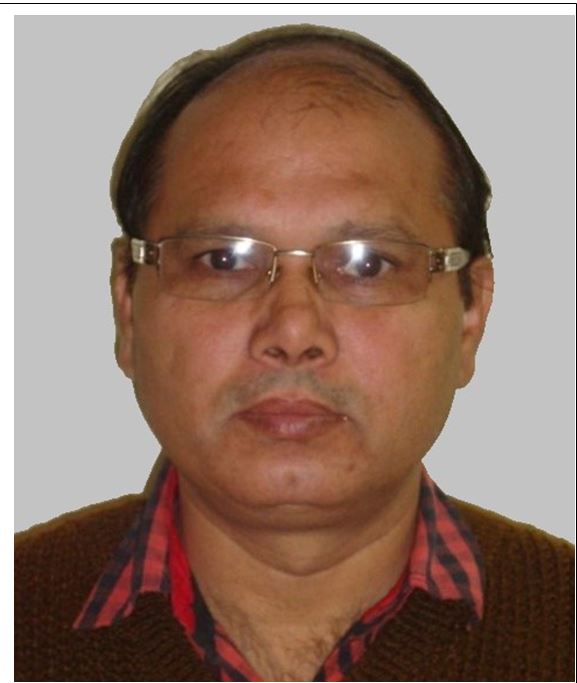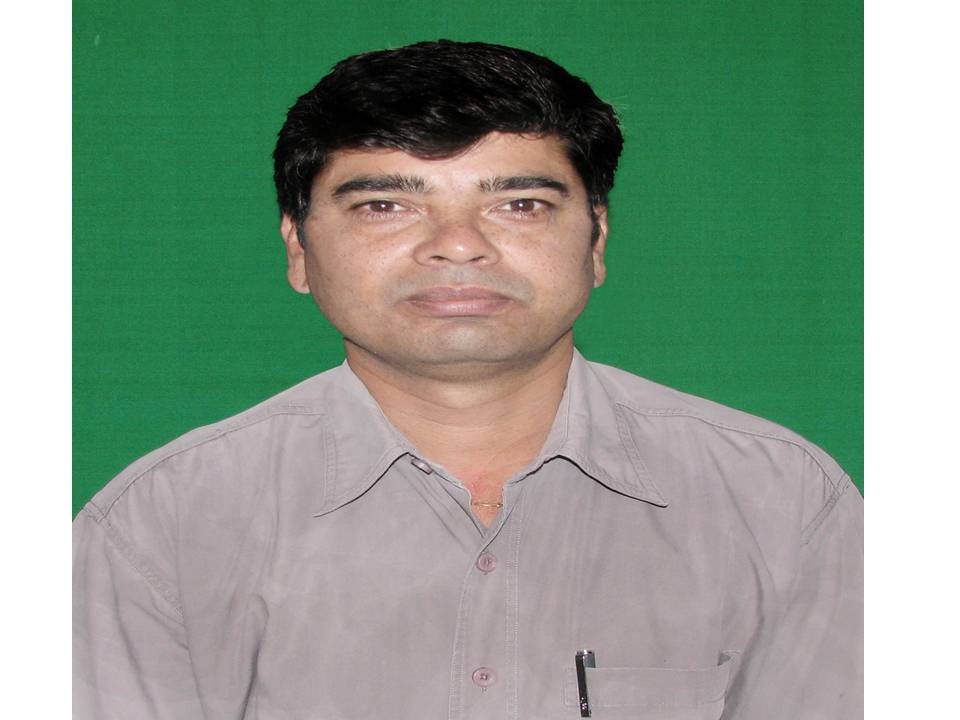Division of Crop Improvement
Introduction
The Crop Improvement Division was established in the VIII Plan when the Directorate of Pulses Research attained the status of Indian Institute of Pulses Research on 5th September 1993. However, research efforts on breeding improved varieties of pulses were initiated with the establishment of Directorate on Pulses Research in 1984. The Division encompasses a broad range of activities from basic studies on plant genomes to development of improved varieties. The Division includes plant breeding, genetics & cyto-genetics and molecular breeding till 2012. In addition, plant genetic resource management and quality seed production are integral parts of the Division. The mandate crops are chickpea, pigeonpea, mungbean, urdbean, lentil, fieldpea, rajmash, lathyrus, cowpea, ricebean and horsegram.
Thrust areas:
- Exploitation of heterosis in pigeonpea
- Integrated approach for genetic enhancement through pre-breeding
- Development of suitable plant types for different agro-ecological conditions
- Genomics-enabled improvement of pulse crops
- Breeding for tolerance to drought & temperature extremities
- Breeding for improved quality
- Plant genetic resources management
- Maintenance breeding, breeder seed production and seed research
Crop wise priority areas:
Chickpea:
- Genetic enhancement and pre-breeding for yield enhancement and broadening the genetic base of existing cultivars.
- Pyramiding of genes conferring resistance to fusarium wilt and dry root rot through integrated plant breeding approach).
- Development of heat and moisture stress tolerant varieties (QTLs identification for drought, mechanism of heat tolerance etc.).
- Development of chickpea varieties suitable for mechanical harvesting and post emergence herbicide tolerance.
- Genetic enhancement for nutritional quality, grain quality, milling and processing attributes.
Pigeonpea:
- Exploitation of heterosis and development of commercial CGMS based hybrids.
- Development of improved varieties possessing resistance to major biotic and abiotic stresses, and genetic enhancement through pre-breeding in long duration pigeonpea.
- Development of early maturing varieties insulated against pod fly damage.
Urdbean:
- High yielding varieties with sympodial bearing (soybean type), green or black seeds, possessing resistance against yellow mosaic virus and Cercospora leaf spot.
- Development of high yielding, MYMIV/MYMV and Cercospora leaf spot resistant varieties for spring/summer seasons.
Mungbean:
- Genetic improvement for grain yield and multiple biotic and abiotic stress resistance
- Development of medium-short duration and pre-harvest sprouting tolerant mungbean varieties with multiple disease resistance for kharif season.
Lentil:
- High yielding varieties possessing resistance to fusarium wilt, rust and stem phyllium blight, and combining higher biomass and early maturity for rice-fallow and utera cultivation.
Field pea:
- Genetic improvement for grain yield by combining higher biomass, stiff stem and few leaflets traits besides powdery mildew and rust resistance.
Cowpea:
- Development of high-yielding, short-duration, multi-purpose, and multiple stresses resistance genotypes
Research strategies:
- Conventional and marker assisted breeding for enhancement of yield in specific ecological niches of mandate pulse crops.
- Pre-breeding efforts to break yield ceiling and broaden the genetic base.
- Exploitation of three line system of hybrid breeding in pigeonpea.
- Development of mapping populations (bi / multi-parental) for target traits in major pulse crops.
- Mapping and tagging of genes for major diseases and MAS for improving the resistance in high yielding varieties against concerned pathogens.
- Identification of suitable donors for resistance to biotic stresses, tolerance to abiotic stresses, advantageous phenotypic attributes and grain/ nutritional quality traits.
- Conventional breeding for enhancement of nutritional/ grain quality aspects in mandate food legumes.
- Sharing segregating material, donors, germplasm and improved breeding lines with AICRP centres.
- Utilization of off-season nurseries for rapid generation advancement.
- Basic and strategic research that will ultimately give high yielding varieties/improved breeding lines/research papers/improved methodologies and better understanding of mechanisms in view of climate change. Allele mining of genes of agricultural importance.
- Harnessing international/national collaborations for development of feasible methodologies and Human Resource Development in frontier areas of research.
- Maintenance breeding to ensure availability of quality seeds.
Salient Achievements
Varieties developed: Large number varieties of different pulses have been developed by IIPR.
Chickpea:
| Crop Name | Features | Image |
|---|---|---|
| DCP 92-3 (Desi type) | Year of Release: 1998 (CVRC) |  |
| Potential Yield: 20-25 q/ha | ||
| Duration: 140-145 days | ||
| Recommended Area: North West Plain Zone of India | ||
| Ecology: Suitable for timely sown condition | ||
| Special Characters:Tolerant to moisture stress and lodging, wilt resistant, yellowish brown seed colour with small seed size (16.0g/100 seed weight) | ||
| IPCK 2002-29 (Shubhra, Kabuli type) | Year of Release: 2009 (CVRC) | 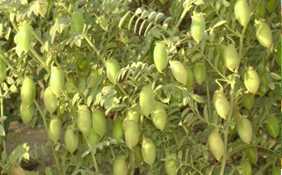 |
| Potential Yield: 20-22 q/ha | ||
| Duration: 105-115 days | ||
| Recommended Area: Central Zone of India | ||
| Ecology:Suitable for irrigated and timely sown condition | ||
| Special Characters:Kabuli type, creamy white seed colour with large seed size (34.0g/100 seed weight), moderately resistant to wilt | ||
| IPCK 2004-29 (Ujjawal, Kabuli type) | Year of Release: 2010 (CVRC) |  |
| Potential Yield: 20-22 q/ha | ||
| Duration: 105-115 days | ||
| Recommended Area:Central Zone of India | ||
| Ecology:Suitable for irrigated and timely sown condition | ||
| Special Characters:Kabuli type, creamy white seed colour with large seed size (35g/100-seed wt.), moderately resistant to fusarium wilt. | ||
| IPC 2006-77 (Desi type) | Year of Release: 2019 (CVRC) | 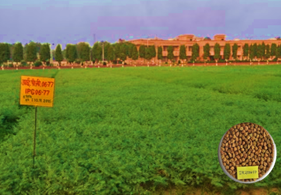 |
| Potential Yield: 20-25 q/ha | ||
| Duration:115-120 days | ||
| Recommended Area:Central Zone | ||
| Ecology:Suitable for irrigated and late sown condition | ||
| Special Characters:Resistance to wilt and moderate tolerant to DRR, stunt, collar rot, light brown seed with small seed size (16.5g/100 seed weight) and higher protein content (>24%). | ||
| IPC 2004-98 (Desi type) | Year of Release: 2020, SVRC (UP) | 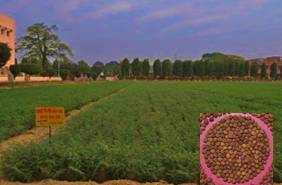 |
| Potential Yield: 18-20 q/ha | ||
| Duration:135-140 days | ||
| Recommended Area:Central and Bundelkhand region of Uttar Pradesh | ||
| Ecology:Suitable for irrigated and timely sown condition | ||
| Special Characters:Resistance to wilt, brown seed colour with large seed size (25.8g/100 seed wt.) | ||
| IPC 2004-01 (Desi type) | Year of Release: 2020, SVRC (UP) |  |
| Potential Yield: 18-20 q/ha | ||
| Duration:120-125 days | ||
| Recommended Area: Central and Bundelkhand region of Uttar Pradesh | ||
| Ecology:Suitable for irrigated and timely sown condition | ||
| Special Characters:Resistance to wilt, brown seed colour with medium seed size (20.2g/100 seed wt.) | ||
| IPC 2005-62 (Desi type) | Year of Release: 2020, SVRC (UP) |  |
| Potential Yield: 18-20 q/ha | ||
| Duration:120-125 days | ||
| Recommended Area:Western and Bundelkhand regions of Uttar Pradesh | ||
| Ecology:Suitable for irrigated and late sown condition | ||
| Special Characters:Resistance to wilt, brown seed colour with small seed (15.2g /100 seed weight), higher protein content (>26%) | ||
| IPC 2011-112 (Keshav, Desi type) | Year of Release:2020, SVRC (UP) | 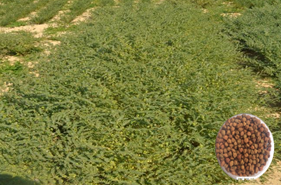 |
| Potential Yield: 20-22 q/ha | ||
| Duration:135-140 days | ||
| Recommended Area:Western regions of Uttar Pradesh | ||
| Ecology:Suitable for irrigated and timely sown condition | ||
| Special Characters:Resistance to wilt, brown seed colour with medium seed size (20.2g/100 seed wt.) | ||
| IPC 2007-28 (Atal, Desi type ) | Year of Release:2021, SVRC (UP) |  |
| Potential Yield: 20-22 q/ha | ||
| Duration:115-125 days | ||
| Recommended Area:Eastern region of Uttar Pradesh | ||
| Ecology:Suitable for irrigated and late sown condition | ||
| Special Characters:Highly resistant to wilt, tolerant to DRR, Collor rot diseases, brown and medium seed size (18.5g/100 seed wt.) | ||
| IPC 2010-134 (Shiva, Desi type) | Year of Release:2021, SVRC (UP) |  |
| Potential Yield: 22-24 q/ha | ||
| Duration:125-135 days | ||
| Recommended Area:Western and Bundelkhand regions of Uttar Pradesh | ||
| Ecology:Suitable for irrigated and timely sown condition | ||
| Special Characters:Highly resistant to wilt, moderately tolerant to DRR, brown and medium seed size (23.0g/100 seed weight) | ||
| IPCK 2013-163 (Madhav, Kabuli type) | Year of Release:2021 (CVRC) |  |
| Potential Yield: 22-24 q/ha | ||
| Duration:125-135 days | ||
| Recommended Area:North West Plain Zone of India | ||
| Ecology:Suitable for irrigated and timely sown condition | ||
| Special Characters:Seed creamy beige colour with large seed size (28.7g/100 seed weight) and moderately resistance to fusarium wilt, dry root rot and collar rot, stunt diseases. | ||
| IPCL 4-14 (Desi Type, MAS product) | Year of Release:2021 (CVRC) | 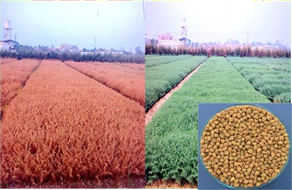 |
| Potential Yield: 18-20 q/ha | ||
| Duration:130-135 days | ||
| Recommended Area:North West Plain Zone of India | ||
| Ecology:Suitable for irrigated and timely sown condition | ||
| Special Characters:Drought tolerant MAS product. Seed light brown colour with small seed size (16.6g/100 seed weight) and resistance to fusarium wilt, collar rot, stunt diseases and moderately tolerant to dry root rot. |
Pigeonpea:
| Crop Name | Features | Image |
|---|---|---|
| IPA 203 (Prakash) | Year of Release: 2015 (CVRC) | 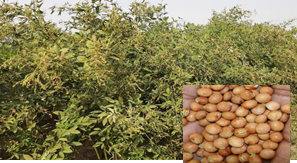 |
| Potential Yield: 25-28 q/ha | ||
| Duration:249-255 days | ||
| Recommended Area: North East Plain Zone | ||
| Special Characters:Resistant to fusarium wilt, light brown colour seed with medium size seed (12-14 g/100-seed) | ||
| IPA 206 (Ganga) | Year of Release: 2019, SVRC (UP) |  |
| Potential Yield: 25-26 q/ha | ||
| Duration: 245-250 days | ||
| Recommended Area: Uttar Pradesh | ||
| Special Characters:Resistant to wilt and SMD, purple seed colour with medium size seed (10- 11 g/100-seed wt.) | ||
| IPA 15-2 (Sharada) | Year of Release: 2020 (CVRC) | 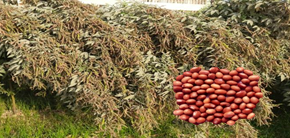 |
| Potential Yield: 28-33 q/ha | ||
| Duration: 240-255 days | ||
| Recommended Area:North East Plain Zone | ||
| Special Characters:Resistant to fusarium wilt and sterility mosaic, brown colour seed with medium size seed (10-12 g/100 seed) | ||
| IPH 15-03 (Hybrid) | Year of Release: 2020 (CVRC) |  |
| Potential Yield: 24-25 q/ha | ||
| Duration:150-155 days | ||
| Recommended Area:North West Plain Zone | ||
| Special Characters:Hybrid variety resistant to wilt, brown seed colour with medium seed size (8- 8.54 g /100 seed wt.) | ||
| IPH 9-05 (Hybrid) | Year of Release:2021 (CVRC) | 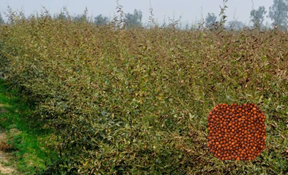 |
| Potential Yield: 22-23 q/ha | ||
| Duration:150-155 days | ||
| Recommended Area: North West Plain Zone | ||
| Special Characters:Hybrid variety tolerant to Phytophthora blight, sterility mosaic and moderately resistant to wilt, medium seed size (9- 9.6 g/100-seed) | ||
| IPAE 15-6 | Year of Release: 2021 (CVRC) | 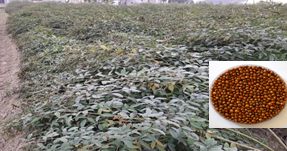 |
| Potential Yield: 21-25 q/ha | ||
| Duration:129-149 days | ||
| Recommended Area:Central zone | ||
| Special Characters:Tolerant to sterility mosaic, phytophthora blight and moderately resistant to wilt, medium brown seed size (9.5-10 g/100-seed) |
Mungbean:
| Crop Name | Features | Image |
|---|---|---|
| PDM 11 | Year of Release: 1987 (CVRC) | 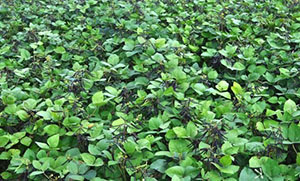 |
| Average Yield: 8-10 q/ha | ||
| Duration:75 days | ||
| Recommended Area: North East Plain Zone, Central Zone | ||
| Special Characters:Resistant to yellow mosaic disease | ||
| PDM 54 (Moti) | Year of Release: 1987 (CVRC) | 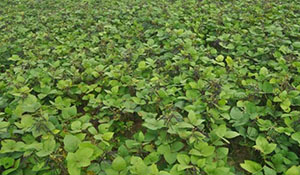 |
| Average Yield:8-10 q/ha | ||
| Duration: 65 days | ||
| Recommended Area: North West Plain Zone, North East Plain Zone | ||
| Special Characters:Early maturity, large seeds, multiple disease resistance | ||
| PDM 139 (Samrat) | Year of Release: 2001, SVRC (UP) | 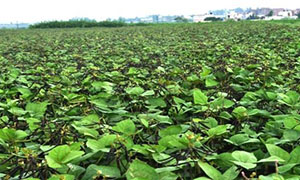 |
| Average Yield: 10-12 q/ha | ||
| Duration: 58-62 days | ||
| Recommended Area:Uttar Pradesh | ||
| Special Characters:Early maturity, MYMV resistance, shining green seed | ||
| IPM 99-125 (Meha) | Year of Release: 2004 (CVRC) | 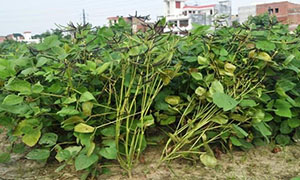 |
| Average Yield: 12-15 q/ha | ||
| Duration: 65-72 days | ||
| Recommended Area:North East Plain Zone | ||
| Special Characters:Early maturity, MYMV resistance | ||
| IPM 02-3 | Year of Release:2009 (CVRC) |  |
| Average Yield: 12-15 q/ha | ||
| Duration:65-70 days | ||
| Recommended Area: North West Plain Zone | ||
| Special Characters:Photo and thermo-insensitive with highly resistance to YMD | ||
| IPM 2-14 | Year of Release: 2011 (CVRC) | 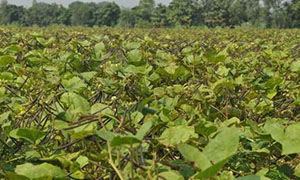 |
| Average Yield:12-14 q/ha | ||
| Duration:62-65 days | ||
| Recommended Area:South Zone | ||
| Special Characters:Highly resistant YMD | ||
| IPM 205-7 (Virat) | Year of Release: 2016 (CVRC) | 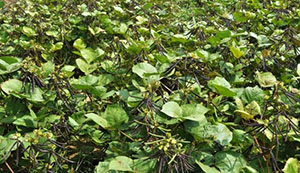 |
| Average Yield:13-15 q/ha | ||
| Duration:55 days | ||
| Recommended Area:Karnataka, TN, MP, Gujarat , Rajasthan, Maharashtra, UP | ||
| Special Characters:Highly resistant to YMD, PM and CLS | ||
| IPM 410-3 (Shikha) | Year of Release:2016 (CVRC) | 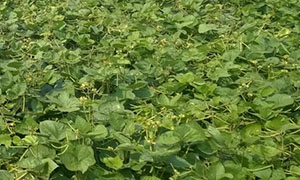 |
| Average Yield:13-16 q/ha | ||
| Duration:60-65 days | ||
| Recommended Area:North West Plain Zone, Central Zone | ||
| Special Characters:Highly resistant to YMD, PM, CLS | ||
| IPM 2014-9 (Varsha) | Year of Release: 2018, SVRC (UP) | 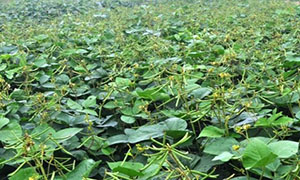 |
| Potential Yield: 10-12 q/ha | ||
| Duration:65-75 days | ||
| Recommended Area:Uttar Pradesh | ||
| Special Characters:Highly resistant to YMD, PM, mod resistant to CLS | ||
| IPM 302-2 (Kanika) | Year of Release: 2018, SVRC (UP) | 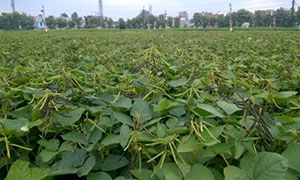 |
| Potential Yield: 10-12 q/ha | ||
| Duration:70-75 days | ||
| Recommended Area:Uttar Pradesh | ||
| Special Characters:Highly resistant to YMD, PM, resistant to leaf curl. | ||
| IPM 312-20 (Vasudha) | Year of Release: 2020, SVRC (UP) |  |
| Potential Yield: 12-14 q/ha | ||
| Duration:70-80 days | ||
| Recommended Area:Uttar Pradesh | ||
| Special Characters:Resistant to YMD, PM and cercospora leaf spot. | ||
| IPM 409-4 (Heera) | Year of Release: 2020, SVRC (UP) | 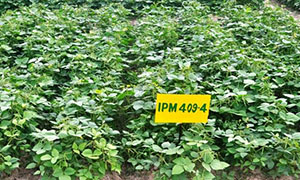 |
| Potential Yield: 11-12 q/ha | ||
| Duration:70-74 days | ||
| Recommended Area:Uttar Pradesh | ||
| Special Characters:Resistant to YMD, PM and CLS | ||
| IPM 512-1 (Soorya) | Year of Release: 2020 (CVRC) | 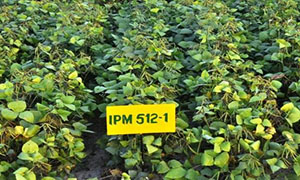 |
| Potential Yield: 14-16 q/ha | ||
| Duration:65-70 days | ||
| Recommended Area:North East Plain Zone | ||
| Special Characters:Highly resistant to YMD, CLS and anthracnose |
Urdbean:
| Crop Name | Features | Image |
|---|---|---|
| PDU 1 (Basant Bahar) | Year of Release: 1991 (CVRC) |  |
| Potential Yield: 9-10 q/ha | ||
| Duration:70-80 days | ||
| Recommended Area: North West Plain Zone, Central Zone | ||
| Special Characters:MYMV tolerant, good plant type | ||
| IPU 94-1 (Uttara) | Year of Release: 1999 (CVRC) | 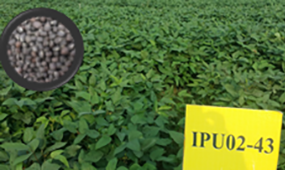 |
| Potential Yield:12-14 q/ha | ||
| Duration:80-85 days | ||
| Recommended Area: North West Plain Zone, North East Plain Zone | ||
| Special Characters:MYMV resistant, attractive plant type | ||
| IPU 02-43 | Year of Release: 2008 (CVRC) |  |
| Potential Yield:10-12 q/ha | ||
| Duration:70-72 days | ||
| Recommended Area:South Zone | ||
| Special Characters:MYMV and Powdery mildew resistant | IPU 11-02 | Year of Release:2019, SVRC (UP, MP) | 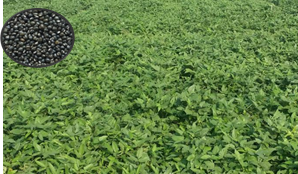 |
| Potential Yield: 10-12 q/ha | ||
| Duration:80-85 days | ||
| Recommended Area: Madhya Pradesh and Uttar Pradesh | ||
| Special Characters:Dull black colour with medium large seed (4.3g/100 seed wt.) and high protein content (26%), resistant to MYMV, ULCV, PM, anthracnose and Cercospora leaf spot | ||
| IPU 10-26 | Year of Release:2019, SVRC (MP) | 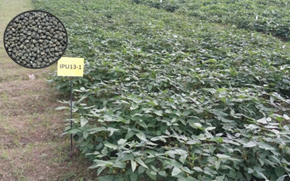 |
| Potential Yield: 10-12 q/ha | ||
| Duration:70-75 days | ||
| Recommended Area: Madhya Pradesh | ||
| Special Characters:Shining black seed colour, medium large seed (3.82g/100 seed wt.) with high protein content (25%), highly resistant to MYMV, Cercospora leaf spots and resistant to ULCV, stem necrosis, web blight, BLB, anthracnose, PM |
Lentil:
| Crop Name | Features | Image |
|---|---|---|
| DPL 15 (Priya) | Year of Release: 1995 (CVRC) | 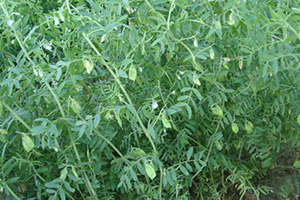 |
| Potential Yield: 15-16 q/ha | ||
| Duration:135-140 days | ||
| Recommended Area: North West Plain Zone | ||
| Special Characters:Resistant to rust and tolerance to wilt | ||
| DPL 62 (Sheri) | Year of Release: 1997 (CVRC) |  |
| Potential Yield:17-18 q/ha | ||
| Duration:130-135 days | ||
| Recommended Area: North West Plain Zone | ||
| Special Characters:Resistant to rust and tolerance to wilt with large seeds | ||
| IPL 81 (Noori) | Year of Release: 2000 (CVRC) | 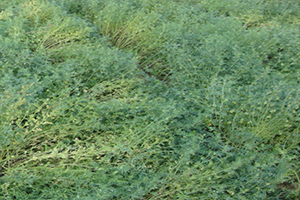 |
| Potential Yield:12-14 q/ha | ||
| Duration:110-115 days | ||
| Recommended Area:Central Zone | ||
| Special Characters:Tolerant to rust and wilt, medium size seeds | ||
| IPL 406 (Angoori | Year of Release: 2007 (CVRC) |  |
| Potential Yield:17-18 q/ha | ||
| Duration: 125-130 days | ||
| Recommended Area:North West Plain Zone | ||
| Special Characters:Tolerant to rust and wilt, extra-large seeds | ||
| IPL 316 | Year of Release:2013 (CVRC) |  |
| Potential Yield: 18-20 q/ha | ||
| Duration:102-112 days | ||
| Recommended Area:Central Zone | ||
| Special Characters:Resistance to wilt and rust. Seed brown with red cotyledons and large (3.1g/100 seed wt.) | ||
| IPL 526 | Year of Release:2015, SVRC (UP) |  |
| Potential Yield: 10-15 q/ha | ||
| Duration:105-112 days | ||
| Recommended Area: Uttar Pradesh | ||
| Special Characters:Tolerance to wilt and rust diseases, seed attractive with large size (3.0 g/100 seeds) and red cotyledons | ||
| IPL 220 (Biofortified variety) | Year of Release:2018 (CVRC) | 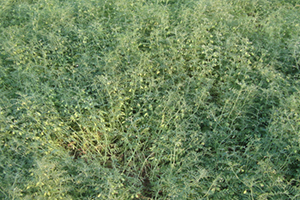 |
| Potential Yield: 15-20 q/ha | ||
| Duration:120-125 days | ||
| Recommended Area:North East Plain Zone | ||
| Special Characters:Resistance to rust, wilt and stemphylium blight, brown seed coat with orange cotyledon and small seeded (2.4g/100 seed wt), high Zn& Fe content | ||
| IPL 321 | Year of Release:2018, SVRC (UP) |  |
| Potential Yield:12-14 q/ha | ||
| Duration:125-135 days | ||
| Recommended Area:Uttar Pradesh | ||
| Special Characters:Resistant to wilt with large seeded | ||
| IPL 315 | Year of Release:2019, SVRC (UP) | 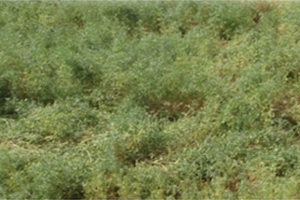 |
| Potential Yield: 15-20 q/ha | ||
| Duration:129-138 days | ||
| Recommended Area: Uttar Pradesh | ||
| Special Characters:Resistant to rust and tolerant to wilt. Seed brown colour with orange cotyledons and large size (2.9 g/100 seed-weight) | ||
| IPL 534 | Year of Release:2019, SVRC (MP) |  |
| Potential Yield: 14-16 q/ha | ||
| Duration:100-107 days | ||
| Recommended Area: Madhya Pradesh | ||
| Special Characters:Early maturing, Resistance to rust, wilt and stem phylium blight. Seed brown with red cotyledons and large size (3.2g/100 seed wt.) | ||
| IPL 225 | Year of Release:2020, SVRC (UP) |  |
| Potential Yield: 12-14 q/ha | ||
| Duration:105-133 days | ||
| Recommended Area: Uttar Pradesh | ||
| Special Characters:Highly resistance to rust and wilt diseases and small seeded (2.1 g/100 seeds), brown dotted seed coat and red cotyledons | ||
| IPL 329 | Year of Release:2020, SVRC (UP) | 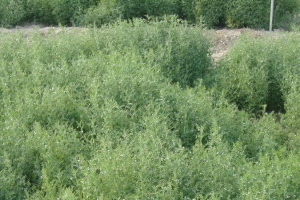 |
| Potential Yield:12-14 q/ha | ||
| Duration:115-134 days | ||
| Recommended Area: Uttar Pradesh | ||
| Special Characters:Resistance to rust and wilt diseases and large seeds (2.9g/100 seeds) with brown dotted seed coat and red cotyledons |
Fieldpea
| Crop Name | Features | Image |
|---|---|---|
| IPF 99-25 (Adarsh) | Year of Release:2000 (CVRC) |  |
| Potential Yield: 23-24 q/ha | ||
| Duration:110-115 days | ||
| Recommended Area: Central Zone | ||
| Special Characters:Tall, Powdery mildew resistance | ||
| IPFD 99-13 (Vikas) | Year of Release: 2005 (CVRC) |  |
| Potential Yield:22-25 q/ha | ||
| Duration:100-105 days | ||
| Recommended Area: Central Zone | ||
| Special Characters:Dwarf, Powdery mildew resistance | ||
| IPFD 01-10 (Prakash) | Year of Release: 2006 (CVRC) |  |
| Potential Yield:22-25 q/ha | ||
| Duration:110-115 days | ||
| Recommended Area:Central Zone, North Hill Zone | ||
| Special Characters:Large seeds, Powdery mildew resistance | ||
| IPF 05-19 (Aman) | Year of Release: 2009 (CVRC) |  |
| Potential Yield:22-25 q/ha | ||
| Duration: 120-130 days | ||
| Recommended Area:North West Plain Zone | ||
| Special Characters:Powdery mildew resistance, tolerant to rust | ||
| IPF 04-9 | Year of Release:2010, SVRC (UP) |  |
| Potential Yield: 18-20 q/ha | ||
| Duration:125-130 days | ||
| Recommended Area:Uttar Pradesh | ||
| Special Characters:Powdery mildew resistance, tolerant to rust | ||
| IPFD 10-12 (Green seed) | Year of Release:2014 (CVRC) |  |
| Potential Yield:21-22 q/ha | ||
| Duration:110-115 days | ||
| Recommended Area: Central Zone | ||
| Special Characters:Resistant to powdery mildew, Dwarf type, green seeds | ||
| IPFD 11-5 | Year of Release:2016 (CVRC) |  |
| Potential Yield: 22-23 q/ha | ||
| Duration:105-110 days | ||
| Recommended Area:Central Zone | ||
| Special Characters:Creamy white with round seeded, resistant to powdery mildew disease and moderately tolerant to pod borer | ||
| IPFD 6-3 | Year of Release:2016, SVRC (UP) |  |
| Potential Yield:19-20 q/ha | ||
| Duration:115-120 days | ||
| Recommended Area:Uttar Pradesh | ||
| Special Characters:Round seeded & creamy white seed coat colour with resistant to powdery mildew, tolerant to rust | ||
| IPFD 12-2 | Year of Release:2017 (CVRC) |  |
| Potential Yield: 22-25 q/ha | ||
| Duration:110 days | ||
| Recommended Area: Central Zone, | ||
| Special Characters:White and round seeded with resistant to powdery mildew disease, pod borer and moderately resistant to aphids and leaf miner | ||
| IPFD 14-2 | Year of Release:2018 (CVRC) |  |
| Potential Yield: 22-23 q/ha | ||
| Duration:105-110 days | ||
| Recommended Area:Central Zone | ||
| Special Characters:Tan colour mottled seed with resistant to powdery mildew | ||
| IPF 16-13 (Harit, Green seed) | Year of Release:2020 (CVRC) |  |
| Potential Yield:18-20 q/ha | ||
| Duration:115-120 days | ||
| Recommended Area: NEPZ | ||
| Special Characters:Round and green seeded variety with resistant to powdery mildew disease | ||
| IPFD 9-2 | Year of Release:2019, SVRC (UP) |  |
| Potential Yield:20-22 q/ha | ||
| Duration:125-130 days | ||
| Recommended Area: Uttar Pradesh | ||
| Special Characters:Round and creamish white colour seed variety with resistant to powdery mildew disease | ||
| IPFD 12-8 (Aakash) | Year of Release:2020, SVRC (UP) |  |
| Potential Yield:20-22 q/ha | ||
| Duration:120-130 days | ||
| Recommended Area: Uttar Pradesh | ||
| Special Characters:Resistant to powdery mildew and rust disease, dwarf and leafy type with medium creamish white round seed | ||
| IPFD 13-2 (Anant) | Year of Release:2020, SVRC (UP) |  |
| Potential Yield:20-22 q/ha | ||
| Duration:115-125 days | ||
| Recommended Area: Uttar Pradesh | ||
| Special Characters:Resistant to powdery, Downey mildew and rust disease, medium seed size with round, smooth and white seed colour |
Rajmash
| Crop Name | Features | Image |
|---|---|---|
| PDR 14 (Uday) | Year of Release: 1991 (CVRC) |  |
| Potential Yield: 20-22 q/ha | ||
| Duration:125-130 days | ||
| Recommended Area: North East Plain Zone | ||
| Special Characters:Tolerance to BCMV and variegated red seeds | ||
| IPR 96-4 (Amber) | Year of Release: 2002 (CVRC) |  |
| Potential Yield:20-24 q/ha | ||
| Duration:139-145 days | ||
| Recommended Area:North East Plain Zone | ||
| Special Characters:Resistant to BCMV & leaf crinckle | ||
| IPR 98-5 (Utkarsh) | Year of Release: 2005 (CVRC) |  |
| Potential Yield:24-25 q/ha | ||
| Duration:122-125 days | ||
| Recommended Area:North East Plain Zone | ||
| Special Characters:Tolerance to BCMV, Cold tolerance, attractive seed colour | ||
| IPR 98-3-1 (Arun) | Year of Release: 2007 |  |
| Potential Yield:24-25 q/ha | ||
| Duration: 120-125 days | ||
| Recommended Area:Central Zone | ||
| Special Characters:Tolerance to BCMV, attractive dark red medium seeds |
Genetic stocks/ Donors registered
| Crops | Genetic Stock/ Donor/ population | Trait for which registered |
|---|---|---|
| Chickpea | ICC 12315 (INGR 21142) | Post emergence herbicide tolerance (Imazethapyr) |
| IPC 2020-198 (INGR 21141) | > 2 seeds per pod in ≥30% pods per plant (mean seeds per pod = 2.62) | |
| ICC 15925 (INGR 21144) | Heat tolerance | |
| IPC 2010-121 (INGR ) | Resistance to fusarium wilt | |
| DCP 92-3 / ICC92944, n=210 | Mapping population developed for heat tolerance | |
| Pigeonpea | IPAC 79 (INGR 20023) | Tolerance to waterlogging stress. |
| IPAV 16-1 (INGR 20025) | Wilt resistance and extra large seed size | |
| Urdbean | IPU19-27 (registered line) | Early maturity, suitable for high rainfall areas, suitable for spring/summer/kharif |
| Mung bean | IPM 205-7 (INGR11044) | Extra early maturing genotype (52-55 days) |
| IPM 409-4 INGR11043 | Extra early maturing genotype (52-55 days) | |
| IPM604-1-7 (INGR21104) | Yellow seed coat colour, early maturity | |
| V. glabrescens (INGR21143) | Photo- and thermo period insensitive | |
| V. umbellata (INGR21226) | Photo- and thermo period insensitive | |
| V. vexillata (INGR22039) | Resistant against Callosobruchus maculatus | |
| V. umbellata (INGR22041) | Resistant against Callosobruchus maculatus | |
| IPM 526-11(INGR22046) | Highly resistant to yellow mosaic disease caused by Mungbean yellow mosaic India virus | |
| V. stipulaceae (INGR22040) | Early flowering (20DAS) and early maturity (49DAS) | |
| Fieldpea | P-637 (INGR19075) | Post emergence herbicide (Metribuzin) tolerant genotype |
| IPFD 18-14(INGR21140) | Extra early genotype that matures in less than 85 days | |
| IPF 2014-13 (INGR21227) | Resistant to rust | |
| IPF 2014-16(INGR 22043) | Resistant to rust | |
| IPFD 18-26(INGR 22044) | Dwarf, green seeded and extra early genotype | |
| EC 564816(INGR 22045) | Intact/extended funiculus accession | |
| EC 0414478 (INGR21225) | Intact/extended funiculus accession | |
| Rajmash | IC360831 (INGR21136) | Highly Resistant to BCMV disease, High grain yield |
| IC340947 (INGR21103) | Highly Resistant to BCMV disease, High grain yield | |
| Cowpea | EC 762384 (INGR21222) | Dense pubescence |
Plant genetic resources:
Maintenance of wild species
Pre-breeding garden was established at IIPR consisting wild accessions of different pulse crops. The wild accessions in pre-breeding garden include 126 accessions of chickpea (C. pinnatifidum, C judaicum, echinospermum, C. reticulatum, C. chorassanicum, C. bijugum and C. cuneatum); 121 wild accessions of lentil belonging to 5 species/subspecies (Lens nigricans: 7 acc., L. culinaris ssp. orientalis : 78 acc. , L. culinaris ssp. tomentosus: 1 acc., L. culinaris ssp. odemensis: 13 acc., and L. ervoides: 13 acc.) have been maintained at IIPR. 57 wild accessions of Vigna (V. delzelliana: 5 acc., V. glabrescens: 1 acc.,V. glabrescens: 1 acc., V. hainiana: 5 acc., V. mungo var. mungo: 5 acc., V. mungo var. sylvestris: 5 acc., V. pilosa: 3 acc., V. radiata var. radiate: 5 acc., V. radiata var. setulosa: 2 acc., V. radiata var. sublobata: 3 acc., V. trilobata: 8 acc.,V. umbellate: 10 acc., V. unguiculata: 1 acc., V. vexillata: 2 acc. and V. trinervia: 2 acc.) have been collected from Western Ghats and procured from NBPGR are being maintained.
Infrastructure:
National Active Germplasm site
IIPR is also maintaining more than 10 thousand accessions of mandated crops in medium term cold module (4°C with relative humidity 40 %). These accessions can be maintained for 4-5 years under controlled condition without losing the viability of the materials. As a routine activity regular rejuvenation of these accessions are being carried out time to time. This active collection with valuable germplasm is available for sharing with research workers in the country as and when indented under a proper MTA for its use in research purpose only.
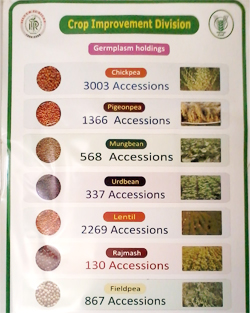
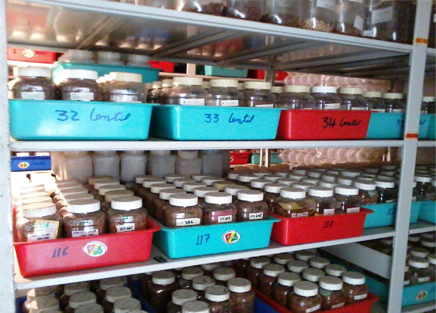
Molecular breeding laboratory
The Division has excellent facilities for basic research on molecular marker assisted breeding and bio-informatics. This comprises well equipped laboratories, medium-term cold modules, rainout shelters, glasshouses, environmental controlled chambers, and net houses. The laboratories have the latest equipment like Thermal Cycler, Gel Documentation system, Advanced Research Microscope, UV-VLS Spectrophotometer, Ultra Centrifuge, Tetrad PRC etc.
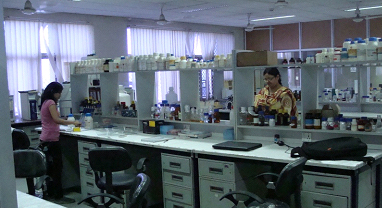
Highthroughput hybridization facility
The Division has an excellent highthroughput hybridization facility for carrying out hybridization work round-the-year under controlled conditions. This facility is especially suitable for short-statured crops such as mungbean, urdbean, chickpea and lentil.
Solar Bubble dryers
The division has a facility of 8 nos. of solar bubble dryers which are of tremendous importance for drying of bulk harvested seeds to bring their moisture content to safe storage levels. This facility is especially important for kharif season when the ambient moisture content is usually very high and pulses such as mungbean, urdbean and pigeonpea can be dried in a much faster way using solar bubble dryers.
Quality Seed Production
Institute is providing nucleus seed of high yielding varities of different pulse crops to ensure genetic purity. More than 500 quintals of breeder seed of six crops (chickpea, pigeon pea, mungbean, urdbean lentil and fieldpea) is being produced annually besides truthfully labelled seeds.
Scientists and their area of specialization

